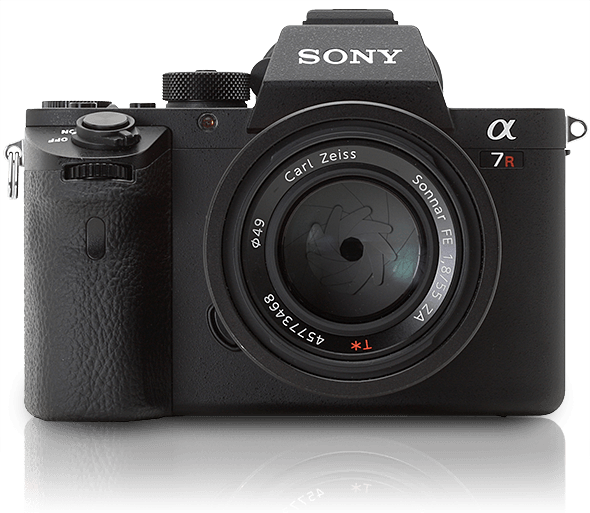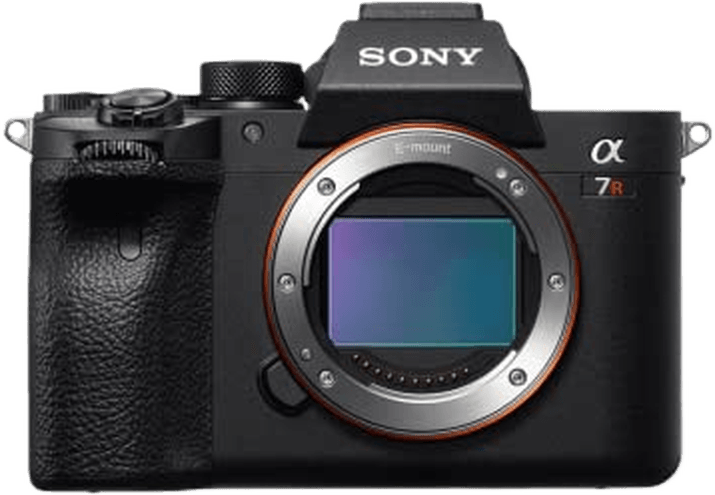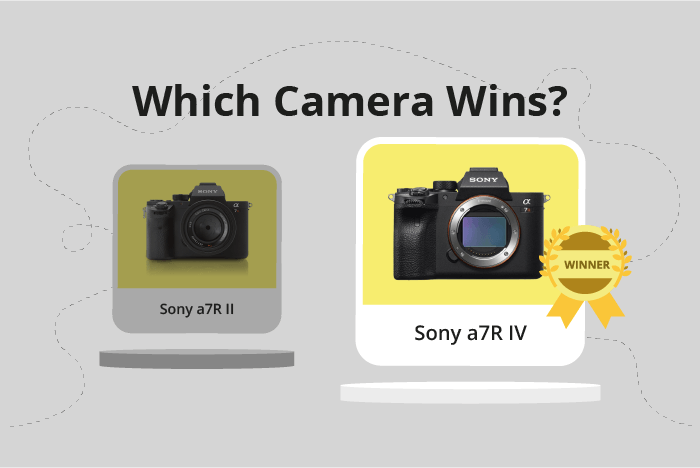Sony a7R II vs a7R IV Comparison
Sony a7R II

Sony a7R IV

The Sony a7R IV outperforms the Sony a7R II with a score of 84/100 compared to 70/100. Both cameras are mirrorless and share similar dimensions, with the a7R IV being slightly larger at 129 x 96 x 78mm and heavier at 665g. The a7R II, released in 2015, is lighter and more compact, weighing 625g and measuring 127 x 96 x 60mm.
The higher score of the a7R IV is due to its improved features, such as better image quality and performance. However, the a7R II still holds its ground with a lower launch price of $3198 compared to the a7R IV’s $3500.
Taking all factors into consideration, the Sony a7R IV is the superior choice for those seeking top performance and image quality, while the Sony a7R II remains a solid option for budget-conscious photographers.
Sony a7R II vs a7R IV Overview and Optics
The Sony a7R IV outperforms the Sony a7R II in optics, with a score of 85/100 compared to the a7R II’s 81/100. Both cameras share several specifications, including a CMOS sensor, Bionz X processor, full-frame sensor size, Sony FE lens mount, and image stabilization. Despite these similarities, there are key differences that contribute to the a7R IV’s higher optics score.
The a7R IV boasts a remarkable 61.2 megapixels, a significant increase from the a7R II’s 42.4 megapixels. This allows the a7R IV to capture more detailed and higher resolution images. Additionally, the a7R IV has a shooting speed of 10 frames per second, doubling the a7R II’s 5 frames per second. This improved shooting speed enables the a7R IV to excel in capturing fast-paced action and fleeting moments.
The Sony a7R II, however, has a slightly lower DXOMARK sensor score of 98, compared to the a7R IV’s 99. This difference is minimal and does not have a significant impact on the overall image quality. Furthermore, the a7R II still produces high-quality images with its 42.4-megapixel sensor, making it a suitable option for many photographers.
In conclusion, the Sony a7R IV’s higher optics score is due to its increased megapixels and shooting speed, resulting in superior image quality and performance. While the Sony a7R II has a marginally lower score, it remains a viable option for those seeking a high-quality camera with similar specifications. Ultimately, the choice between the two cameras depends on individual preferences and specific photography needs.
Sony a7R II vs a7R IV Video Performance
The Sony a7R IV outperforms the Sony a7R II in video capabilities with a video score of 70/100, compared to the Sony a7R II’s score of 56/100. Both cameras share some common specifications, such as 4K maximum video resolution, maximum video dimensions of 3840 x 2160, and a maximum video frame rate of 30fps. However, there are differences that set the Sony a7R IV apart as the superior camera for video recording.
The winning camera, the Sony a7R IV, has built-in time-lapse functionality, which is absent in the Sony a7R II. This feature allows the user to create stunning time-lapse videos without the need for additional equipment or software. This advantage gives the Sony a7R IV an edge in video capabilities and justifies its higher video score.
On the other hand, the Sony a7R II does not offer any significant advantage over the Sony a7R IV in terms of video capabilities. Both cameras share the same video specifications, with the only difference being the absence of built-in time-lapse functionality in the Sony a7R II. This lack of a unique advantage results in the Sony a7R II’s lower video score.
Taking into account the video specifications, the Sony a7R IV is the clear winner in video capabilities due to its built-in time-lapse functionality. The Sony a7R II, despite having similar video specifications, falls short because of its lack of this feature. Therefore, for users prioritizing video capabilities, the Sony a7R IV is the better choice.
Sony a7R II vs a7R IV Features and Benefits
The Sony a7R IV outperforms the Sony a7R II with a feature score of 83/100 compared to 57/100. Both cameras share several specifications, including a 3-inch screen size, flip screen functionality, WiFi connectivity, and lack of GPS.
The Sony a7R IV surpasses the a7R II in several aspects. Firstly, it offers a higher screen resolution of 1,440,000 dots compared to the a7R II’s 1,228,800 dots, providing a sharper and clearer display. Additionally, the a7R IV features touchscreen capabilities, making it more user-friendly and convenient. Lastly, the a7R IV includes Bluetooth connectivity, allowing for seamless and efficient data transfer between devices.
On the other hand, the Sony a7R II still has a few advantages despite its lower feature score. Its flip screen allows for flexible shooting angles and easier self-portraits. However, this feature is also present in the a7R IV, making it a shared advantage rather than a unique selling point for the a7R II.
Comparing these two cameras, it is evident that the Sony a7R IV exceeds the a7R II in terms of features, particularly in screen resolution, touchscreen capabilities, and Bluetooth connectivity. The a7R II does not offer any exclusive benefits over the a7R IV. Consequently, the Sony a7R IV stands out as the superior choice for those seeking a camera with advanced features and ease of use.
Sony a7R II vs a7R IV Storage and Battery
The Sony a7R IV outperforms the Sony a7R II in storage and battery with a score of 79/100 compared to the latter’s 16/100. Both cameras accept SD, SDHC, and SDXC memory cards. However, the a7R IV has a clear advantage with two memory card slots and compatibility with UHS-II cards, while the a7R II has only one slot and supports Memory Stick Duo, Pro Duo, and Pro-HG Duo cards.
The a7R IV also boasts a significantly longer battery life of 670 shots, using the NP-FZ100 battery type, while the a7R II’s NP-FW50 battery allows for 290 shots. Additionally, the a7R IV can charge via USB, which is not possible with the a7R II.
Despite these differences, the a7R II remains a viable option for those who prioritize a more affordable camera and do not require the extended battery life or additional memory card slot. The Sony a7R IV, however, is the clear winner in terms of storage and battery performance, making it ideal for photographers seeking more advanced capabilities.
Sony a7R II vs a7R IV – Our Verdict
Are you still undecided about which camera is right for you? Have a look at these popular comparisons that feature the Sony a7R II or the Sony a7R IV:

